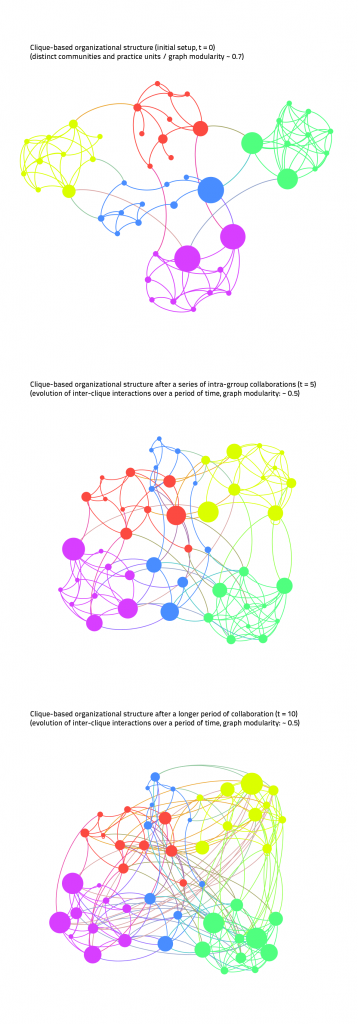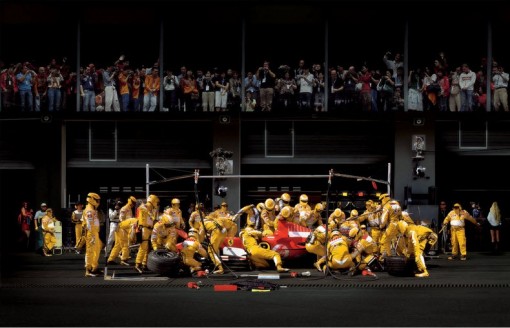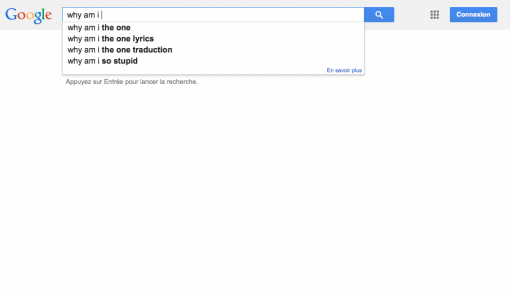Posted by Nodus Labs | December 18, 2013
Fragmentation, Minification, and Cross-Network Alliances
1.
We often hear that the universe is expanding but our own experience is that of the increasing fragmentation. Smaller objects, shorter texts, leaner teams. It’s clearly an important trend that also produces the new challenges. How do we make sense of those bits and pieces of information? How can smaller teams collaborate to serve common purposes?
As the endless simultaneous streams of tweets and status updates proliferate through digital networks, business journals are full of advice on fragmenting organizational structures.
What we’re witnessing is the ongoing transformation of social structures in response to the increasingly fragmented and time-sensitive data streams.
Small project-based temporary teams inspired from DARPA (the agency that invented the internet) are implemented in Motorola Mobile departments by former DARPA executives.
“Practice units” in hospitals that are quickly formed to solve certain tasks and dissolved afterwards to be reintegrated later into a new constellation have shown their efficiency in health care.
What we’re witnessing is the ongoing transformation of social structures in response to the increasingly fragmented and time-sensitive data streams. Hence the increasing importance of cross-network alliances: collaborations and interactions between the nodes that belong to different cliques.
2.
Moreover, even the data itself has to migrate to the new infrastructures that would support its increasing fragmentation and connectivity.
The origin of this very positive challenge come from communicational networks. Packet-size data switching model is employed to transmit information all over the web. When you’re talking on Skype and say “Hello”, the word gets disassembled into small particles, which later get reassembled again when they reach their destination using the meta-information supplied. In the world of data each node in the communicational network acts as a transmitter, concerning itself less with the message, more with the rerouting procedures.
The same behavior is increasingly transposed into social structures. The frequency of communication is increasing, the data packets are becoming smaller and smaller (Facebook updates to Tweets to Snapchat). People “repost”, “like”, “reiterate” or “release” in a way that has more to do with reflex than with response. Social structures are also becoming more animal-like: small temporary cliques, highly expressed swarming tactics (if only in digital realm), task-oriented assemblages, reflexive over responsive.
Social structures are also becoming more animal-like: small temporary cliques, highly expressed swarming tactics (if only in digital realm), task-oriented assemblages, reflexive over responsive.
There are many advantages in this newly emerging network design. Smaller teams have been shown to be better in adapting to the constantly changing environment. Short informational snippets are much closely related to the relevant moment of time. The common drive to create smart new technology makes it necessary to translate what we already know into a form that can be understood by machines: facts, ideas and the relations between them.
What is important is to create infrastructures that support the emerging network design defined by fragmentation. The tools and the practices that help groups communicate, exchange members, temporarily merge and work towards a common goal will become increasingly in demand.
3.
To merely plunge into the ever-increasing dynamics of fragmentation would be brave but not very smart in the long-term.
First, the ongoing fragmentation increases the power of the brokers – the nodes that connect different cliques together (highest “betweenness centrality” in graph theory terms).
If there’s no mechanism in the network that ensures constant rotation of those brokers, we will merely end up with the same old traditional structures where the power belongs to those who are better connected.
Talking about information and knowledge, we’re talking about increasing importance of cross-disciplinary practices and gradual fading of the periphery. However, it is important not to forget that innovation does not only occur at crossroads, but also beyond the frontiers. Furthermore, an in-depth knowledge of a system is crucial for its stable functioning.
If there’s no mechanism in the network that ensures constant rotation of those brokers, we will merely end up with the same old traditional structures where the power belongs to those who are better connected.
Practically this approach could be realized by building an inter-group knowledge system that would make all information within the organization accessible to every group. The information that’s at the periphery of the groups’ knowledge could be promoted for increased innovative effort, the information at intersection of groups’ ongoing activity would be promoted to foster collaborations.
In the realm of social relations we’re talking about a break from the filter bubble of recommendation algorithms, exploring the groups and people we have nothing in common (according to limited rationality of recommendation systems). Using more channels to diversify one’s social reach and breaking beyond specificity of a predominant infrastructure.
4.
Secondly, it’s important to be aware of dynamically changing nature of network structure.
It has been shown that tightly-knit networks are well-suited for innovation but hierarchical networks are still used in infrastructure support and maintenance.
The knowledge of how social dynamics correlates with the underlying network structure can be useful to understand the principles of organizational formations in the first place.
Either we have to rethink the way we “control” things or we end up with a temporary “practice unit” overseeing the functioning of a nuclear reactor. Probably those will also become minified and will fit into pockets, but before that happens it’s important to realize that different connectivities are better suited for different tasks.
Studies in viral contagion dynamics and information proliferation in networks have demonstrated that standard small-world community structure is very well-suited for maintaining endemic level of infection within the network. In other words, the way people normally used to organize themselves ensures that there’s ongoing plurality of opinions and competing ideologies among different groups.
However, as social networks are forming closely-knit cliques, these new formations are much more prone to adopt a singular point of view.
The knowledge of how social dynamics correlates with the underlying network structure can be useful to understand the principles of organizational formations in the first place.
5.
Thirdly, when things are fragmented and small they need to communicate and collaborate.
This is not news given the fast-paced emergence of collaborative spaces, emergent sustainable practices, collective strategies, cross-national superstructures, offshore servers, cross-national digital currency (what a coincidence that it’s called BitCoin!) and other happenings in transcendental realms.
What’s new is that those companies quickly fill in the gap providing the highly demanded infrastructure become monopolists at the markets. Google connects web pages together and today defines what we see on the web. AirBnB connects hosts and landlords, getting their 10% cut off most such transactions that occur in the Western world. Facebook created the infrastructure for learning what’s happening among friends and now often controls the way people relate to each other. It’s not surprising those companies are driving the fragmentation, minification and the resulting need for increasing collaboration even further. Think of the multiple chat tabs that pop up in your browser and the constant stream of notifications.
The recommender systems create a well-known phenomenon of a “filter bubble” where we get only what we’re expecting to get.
The newcomers are simply competing for the new markets that they themselves created and territorialized. It’s in their commercial interest to drive the behavior that enabled them to emerge. Therefore the individuals who become subjectified to those networks need to be increasingly aware of the algorithms that govern their interactions. The recommender systems create the well-known phenomenon of “filter bubble” where we get only what we’re expecting to get.
6.
The question of expectations is an important one. The English word has connotations that evoke vision (Latin expectare). The other languages evoke waiting (“ожидание” in Russian) or reaching towards something (“attendre” in French). French). This example is just to show how changing the interface (language in this case) transforms how we expect and, possibly, what we expect and how it’s related to what we want.
The point is that it’s important to not let any infrastructure prevail. It’s good to have a plurality of different practices in one’s disposal and various means to implement them.
The emergent network of fragmented minified bits needs a procedure that will ensure its evolvability and enable it to solve problems that are not only innovative in their core. Small practice units and teams proved themselves well in innovation, healthcare, network-centric warfare, and software development. Probably there are many more fields coming after their transformation takes place.
The point is that it’s important to not let any infrastructure prevail. It’s good to have a plurality of different practices in one’s disposal and various means to implement them.
A practical implementation of this idea would be the tools that make us more intelligent about the processes that we are engaged in. The new software designs for the new infrastructure. Imagine a social network that lets you see news from the people on the periphery of your social circle (almost Google Plus). Imagine a radical new database design for network-like connectivity (Neo4J). Imagine a tool that looks for inconsistencies rather than common places (Linkfluence). Or a tool that helps you read through networks. Imagine (another!) currency that transcends geographical borders (not winner-takes-all BitCoin).
We need more competition and plurality at the new emergent markets of infrastructure that fragmentation brings forth.
We need algorithms that are not more efficient, but more interesting.
We need the people who value these things.
We need to bring back responsive and even responsible behavior into the predominantly reflex-driven environment emerging today. Without forgetting, of course, that following instincts is also good and that reflexes are vital!







